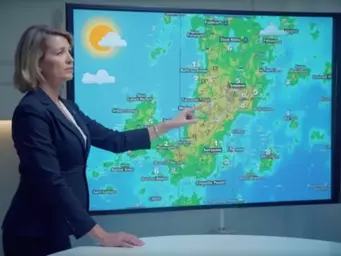Have you ever considered how climate patterns might be influencing the weather outside your window? The intricate dance of these patterns shapes not just our environment but our daily lives. For aspiring meteorologists, grasping these concepts is essential to forecasting our future.
What You Will Learn
- Long-term climate patterns, such as El Niño and La Niña, play a critical role in shaping global weather phenomena.
- Sea surface temperatures significantly influence the development of these climate patterns, affecting precipitation and storm occurrences.
- Understanding the implications of El Niño can help predict increased rainfall in certain regions, while La Niña can lead to drier conditions.
- The connection between ENSO and extreme weather events, like hurricanes and droughts, is vital for disaster preparedness and response strategies.
- Ocean currents also play a significant role in climate variability and can trigger significant weather changes globally.
ENSO Phases and Their Global Weather Impacts
The El Niño-Southern Oscillation (ENSO) significantly influences global weather patterns. Below is a comparison of its two main phases, El Niño and La Niña, highlighting their characteristics and implications.
The Influence of Climate Patterns on Weather Science
Understanding climate patterns is crucial for anyone interested in weather science. These patterns shape our weather and climate, influencing everything from daily temperatures to severe weather events. As someone passionate about meteorology, I find it fascinating how climate patterns like El Niño and La Niña can have such a profound impact on our environment and society.
Understanding Climate Patterns: An Overview
At its core, climate patterns refer to the long-term trends and behaviors in climate data over extended periods. They help us comprehend how different factors interact to produce the weather we experience. This is why studying these patterns is essential for aspiring meteorologists—recognizing them allows us to predict weather conditions more accurately. The global climate report from NOAA provides valuable insights into these trends.
- Temperature Fluctuations: Variations in temperature can indicate shifts in climate patterns.
- Precipitation Trends: Patterns of rainfall can affect water supply and agriculture. For example, the EPA's climate change indicators often highlight changes in heavy precipitation events.
- Storm Frequency: Understanding how often storms occur helps in disaster preparedness.
By analyzing these elements, we can develop a deeper understanding of our planet's climate system. As the owner of the Meteorologist Career Guide, I encourage students to immerse themselves in these fascinating concepts!
Defining El Niño and the Southern Oscillation
The El Niño-Southern Oscillation (ENSO) is a significant climate pattern that affects weather across the globe. When I explain ENSO to students, I often break it down into two main phases: El Niño and La Niña. El Niño is characterized by warmer ocean temperatures in the Pacific, while La Niña features cooler temperatures. These shifts can lead to various weather impacts, such as increased rainfall or drought conditions. The Climate.gov highlights for 2023 offer further context on recent climate phenomena.
- El Niño: Often brings wetter conditions to the eastern Pacific and drier conditions to the western Pacific.
- La Niña: Tends to cause the opposite, with wetter conditions in the western Pacific and drier conditions in the east.
Understanding these phases helps aspiring meteorologists predict and prepare for the varying weather effects associated with each phase.
The Role of Sea Surface Temperatures in ENSO Events
Sea surface temperatures in the Pacific Ocean are crucial for the development of El Niño and La Niña. When these temperatures rise, we often see the emergence of El Niño events, which can lead to significant weather changes across the globe. Conversely, when temperatures drop, La Niña events may occur, bringing about different weather patterns.
- Warm Temperatures: Trigger the El Niño phase, leading to changes in precipitation and storm patterns.
- Cool Temperatures: Indicate La Niña conditions, impacting global weather in distinct ways.
As a meteorologist, being aware of how sea temperatures influence these events is crucial for accurate forecasting!
The Mechanisms Behind ENSO and Its Climate Impact
The Phases of ENSO: Characteristics and Implications
Each phase of ENSO has its unique characteristics, which significantly influence global weather patterns. Understanding these implications is vital for meteorology students looking to grasp the intricacies of weather forecasting.
- El Niño: Can lead to increased rainfall and flooding in some areas while causing drought in others.
- La Niña: Often brings more predictable and stable weather patterns, but can also result in severe weather in certain regions.
By studying these phases, we can better predict how climate patterns will affect weather conditions in different parts of the world.
Linking ENSO to Weather Extremes
ENSO is strongly linked to extreme weather events, which can have devastating effects on communities. Understanding this connection is critical for those pursuing a career in meteorology.
- Hurricanes: El Niño can suppress hurricane activity in the Atlantic while enhancing it in the Pacific.
- Droughts: La Niña often exacerbates drought conditions in certain regions, affecting agriculture and water supplies.
Recognizing these links allows us to prepare for and mitigate the impacts of these extreme events effectively.
Understanding the Influence of Ocean Currents on Climate Patterns
Ocean currents play a significant role in climate variability. They help distribute heat around the planet and influence weather patterns, particularly in relation to ENSO events. As future meteorologists, it’s essential to grasp how these currents impact climate.
- Warm Currents: Can elevate sea surface temperatures, triggering El Niño.
- Cold Currents: May lead to more stable climates, promoting La Niña conditions.
These interactions highlight the complex nature of our climate system and the importance of studying ocean currents in meteorology!
Frequently Asked Questions About Climate Patterns and Weather Science
Engage with Us!
As you delve into the fascinating world of climate science, we’d love to hear your thoughts! What aspect of climate patterns intrigues you the most? Is it the predictive power of ENSO, the impact of ocean currents, or perhaps how these patterns affect extreme weather events? Share your insights below:
Key Takeaways on Climate Patterns and Weather Science
As we've explored throughout this article, understanding climate patterns is essential for grasping the nuances of weather science. These concepts not only help us predict weather events but also enable us to make informed decisions about our environment and lives. By recognizing the interconnectedness of climate and weather, we can better prepare for both the challenges and opportunities that arise from our changing climate.
It's crucial for aspiring meteorologists and anyone interested in weather science to appreciate how climate patterns, such as the El Niño-Southern Oscillation (ENSO), influence global weather systems. With this knowledge, we can work towards more sustainable practices and develop effective policies that address the challenges posed by climate change.
The Importance of Understanding Climate Patterns
Studying climate patterns allows us to anticipate and respond to weather events more effectively. By focusing on phenomena like ENSO, we gain valuable insights that can guide decision-making in various sectors, including agriculture, disaster management, and urban planning. This knowledge empowers communities to build resilience against climate variability.
- Enhances forecasting accuracy for weather events
- Informs emergency preparedness and risk management strategies
- Supports sustainable agricultural practices
- Facilitates climate policy development at local and national levels
As a passionate advocate for weather science, I believe that understanding these patterns is fundamental for anyone looking to make a difference in the field. It’s fascinating how much impact we can have when we leverage knowledge in practical ways!
Engagement and Further Exploration
Stay Informed: Resources for Ongoing Learning
If you're eager to dive deeper into climate science and its implications, there are numerous resources available. Here’s a list of valuable tools and organizations to help you continue your journey:
- Bureau of Meteorology (BOM) - Australia's official weather agency
- Climate.gov.au - Official climate change information portal
- World Meteorological Organization (WMO) - Global authority on weather and climate
- Intergovernmental Panel on Climate Change (IPCC) - Reports and data on climate change science
These resources can serve as excellent starting points for anyone looking to enhance their understanding and keep up with the latest developments in climate science.
Contributing to Climate Awareness and Action
I encourage you to take what you've learned here and share it with your community! Advocacy for climate action is vital, and by engaging with others, we can foster a collective understanding of climate patterns and their impacts. Whether it’s through local initiatives or online platforms, every bit of awareness helps.
Think about ways you can contribute! Are there community groups you can join? Would you consider hosting an event to discuss weather science? Remember, your interest in climate science can lead to meaningful conversations and inspire others to take action!
Recap of Key Points
Here is a quick recap of the important points discussed in the article:
- Understanding Climate Patterns: Climate patterns like El Niño and La Niña are essential for predicting weather and understanding environmental impacts.
- El Niño and La Niña: These phases of the El Niño-Southern Oscillation (ENSO) affect global weather, causing variations in rainfall and temperature.
- Sea Surface Temperatures: Changes in sea surface temperatures in the Pacific Ocean trigger El Niño and La Niña events, impacting weather patterns worldwide.
- Ocean Currents: Warm and cold ocean currents influence climate variability and play a key role in the behavior of ENSO events.
- Weather Extremes: ENSO is linked to extreme weather events such as hurricanes and droughts, making its study critical for disaster preparedness.
- Importance of Education: Aspiring meteorologists should focus on understanding these climate patterns to enhance forecasting accuracy and inform climate policy.










